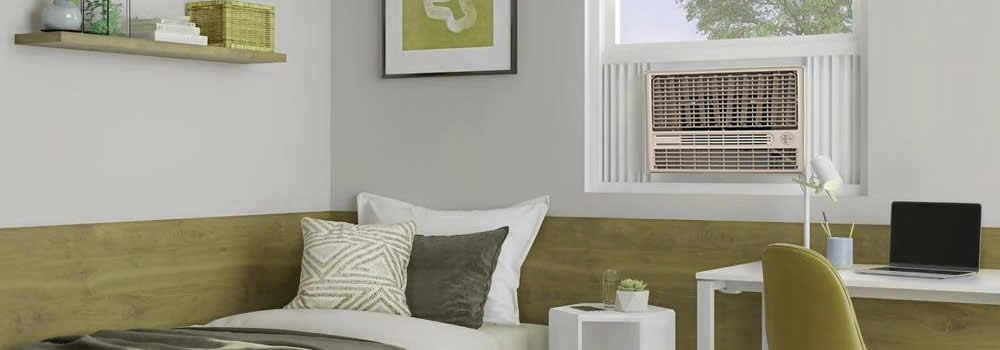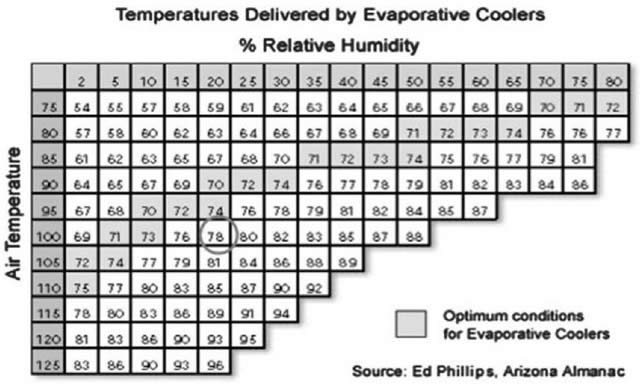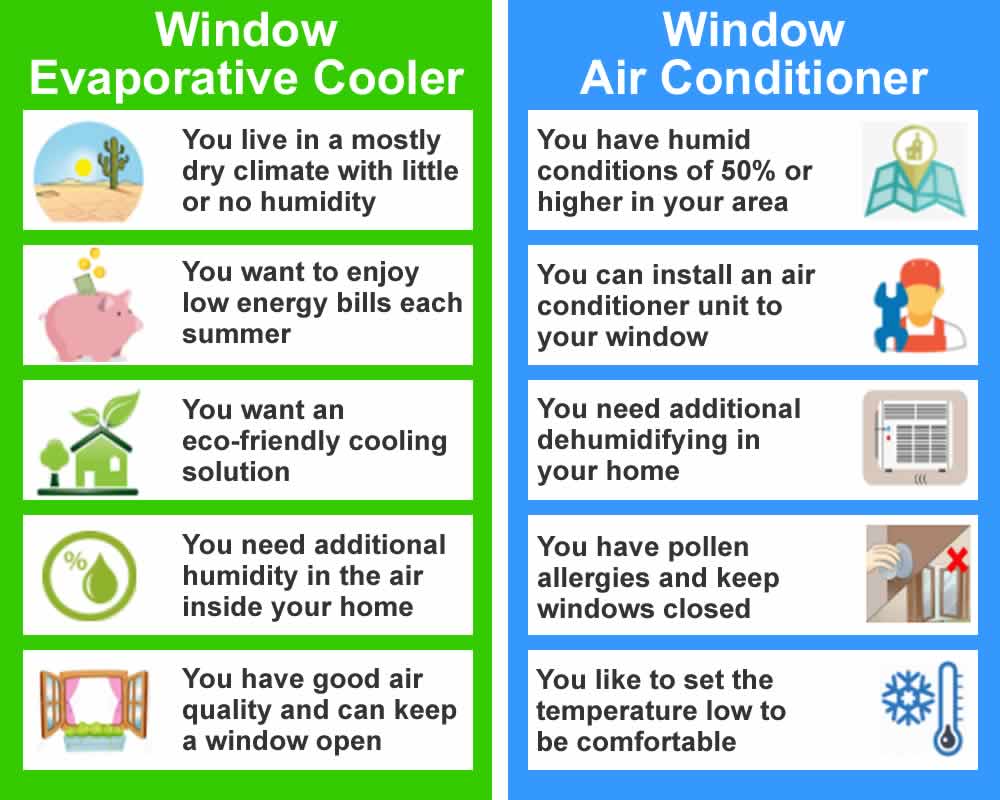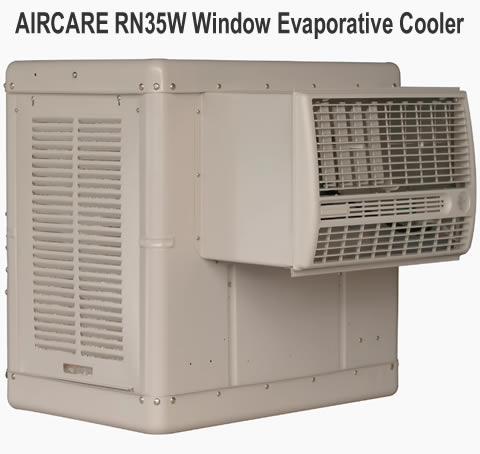- Home
- Air Conditioning
- Window Mounted Evaporative Cooler
Window Mounted Evaporative Cooler: Powerful yet Economical
Did you know you can save money to keep cool in summer by reducing power consumption with a window mounted evaporative cooler instead of an air conditioning unit?
In addition to this type of cooler being easily affordable, it also occupies only a small space in your home.

This type of cooler is easy to mount on a window, and is eco-friendly since there are no ozone-destroying refrigerants present as are found in traditional air conditioners.
Why You Would Choose a Window Evaporative Cooler
Let's deal with the elephant in the room first of all. This type of cooling unit will only be effective in a dry climate, such as in a desert or semi-desert location.
If that describes your location, you're in luck!
Dry Climates
Evaporative (swamp) coolers work really well in dry climates, producing a surprisingly cold airflow that can really bring down the temperature in a room. They also make great spot coolers as well as personal coolers.
If you have ever stood in front of a powerful swamp cooler either indoors or outdoors during hot, dry weather, you'd know just how cold (and welcoming) that blast of chilled air can be!
Why You Would Not Choose a Swamp Cooler
Unfortunately, there is one major drawback with this type of cooler. Swamp coolers do not work well in humid conditions.
If you live in an area that has a humid climate during the hot season, this kind of evaporative cooling appliance will not work so well for you.
Humidity
If your climate is very humid in hot weather, a traditional refrigerant-based air conditioner would be a far better choice for keeping cool.
If, fortunately for you, you happen to live in a dry climate, I can proceed to tell you some more about these amazing low-cost coolers that you might find very interesting!
How a Window Swamp Cooler Works
Let's look at how a window mounted swamp cooler works to produce the cold air that will keep you and your family cool on those uncomfortably hot summer days (and nights).
The way a swamp cooler works is actually quite simple. It achieves this by passing hot, dry air from outside through a damp, porous pad. The air is moved by a powerful fan located inside the unit, serving to both draw hot air in the back (outside the window) and also to force cold air out the front (facing into the room).
Evaporating Moisture
The moisture absorbed in the pad evaporates and cools the air as it flows through and into the room being cooled, adding some humidity to that air.
The evaporating moisture traps heat, effectively removing it from the air, which causes the air temperature to fall by as much as 20-25°F. It is this now chilled air that passes out of the unit into the space to be cooled.
Water Supply
Swamp coolers need a supply of water for them to work properly. This is kept in a reservoir inside the unit at the base.
The water reservoir can be refilled manually or it can be kept continuously supplied via a connected water hose or fixed piping plumbed into the building's water supply.
How Much Does an Evaporative Cooler Lower the Temperature?
The amount an evaporative cooler can lower the temperature in a room depends mainly depends on factors such as:
- The humidity level
- The current temperature
- The size of the room
- How well ventilated the room is
- How well insulated the room (and building in general) is
- The amount of furniture and fabric coverings (such as curtains etc)
- The size and output rating of the cooling unit
As already mentioned, evaporative coolers will work most effectively in dry climates. The higher the level of humidity, the less the cooler will cool the air.
See the chart below to get a better idea of how much the temperature reduction can be when you compare the current temperature with the humidity level.

The size of the room will also make a difference to how much the cooler will reduce the temperature. Larger rooms take longer to cool degree by degree and other factors such as the amount of ventillation in a larger room from outside air can also reduce the amount the temperature will drop inside the room.
A well insulated building will be easier to cool down and keep cool than an uninsulated one. While this factor is more important when using traditional air conditioning, it can also affect the temperature reduction factor for evaporative coolers.
A fully furnished room with lots of window drapes and thick carpets will cool faster because the internal air volume is reduced and heavy drapes help to insulate from the heat outside.
Lastly and most importantly is the size and power output rating of the swamp cooler itself. A large, powerful cooler will cool a room much faster and reduce the temperature more than a smaller, power powered unit.
Window Swamp Cooler vs Window Air Conditioner
Which type of window mounted cooling solution is best for you and your present situation?
Should you opt for a window evaporative cooler to save money and enjoy fresher, unprocessed air or do you live in a humid environment and need a window air conditioner to keep you cool?
Below is a handy cheat sheet that weighs up the pluses and minuses of each type of cooling solution:

How to Know if Your Area has the Right Climate for a Swamp Cooler
There are several ways you can be certain whether an evaporative cooler mounted in a window would be the right choice for you, depending on your local climate.
The most accurate way is to consult your local weather station to determine the average humidity levels during any season, especially during the hot summer months. This is the best way to find out how your local climate is and get long-range humidity predictions from a professional service that absolutely knows your local weather inside out!
Hygrometer
Another accurate way is to invest in a good quality hygrometer that, one set up, measures the level of humidity right there in your own backyard on any given day.
The only downside to this is that it only tells you what the humidity is at the time you are reading it. It won't provide a projection for the whole summer as you can obtain from you local weather station.
Check Out Local Stores
A less accurate but perfectly viable way to find out if your climate is suitable for a window evaporative cooler to cool your home in summer is to consult local hardware stores that sell both air conditioning and evaporative cooling equipment. They will know which form of cooling is best suited to your locality.
You can also kill two birds with one stone by getting a variety of quotations on different cooling appliances and installation costs from different stores.
You could also talk to local HVAC specialists to get their professional opinion, although be aware that their most profitable work is to supply and install larger air conditioning or whole HVAC systems and they may have an obvious bias to this type of equipment!
Correctly Sizing a Window Swamp Cooler
It is important to obtain the right measurements of the space you intend cooling with an evaporative cooling window mounted appliance, to know the correct size of cooler you will require.
Since the air output of window swamp coolers is rated in terms of Cubic Feet per Minute (CFM) of air that is delivered by the appliance, you will need to know the volume of the space to be cooled, measured in cubic feet.
Do arrive at the correct solution, you should measure the length, width and height of the room and write down those figures on a piece of paper. Then grab a calculator, or do some sums on the paper if you're good at arithmetic and do these two calculations:
First, find out the floor area in square feet:
Length(ft) x Width(ft) = Area(sq ft)
Now, find out the total volume of the room in cubic feet:
Length(ft) x Width(ft) x Height(ft) = Volume(cu ft)
With these two results, you can accurately decide the size of cooler you will need.
When buying an evaporative cooler, whether its a window mounted or free standing unit, you will often be provided with a ballpark area figure that the cooler is capable of cooling, given in square feet, in the information literature.
This is a good starting point, but to get a more accurate sizing result, you can also take the unit's CFM value and do the math.
If, for example, your space is :
(L)30ft x (W)30ft x (H)8ft = 7,200cu ft
Taking a general manufacturer provision for air movement and the number of complete air exchanges per hour being between 20-30 for normal domestic environmental circumstances, then taking the lower figure to give us a base figure:
We should expect around 20 air exchanges per hour (or approx 0.3 air exchanges per minute) times the volume of air (the room's area in cubic feet), which in this example is:
7,200cu ft x 0.3 = 2,400 CFM
Of course, this figure will change if the circumstances change.
If for instance there will be several people occupying the space being cooled and perhaps the temperature is on the high side, it may be necessary to factor in a higher CFM to cope with the need for a higher number of air exchanges per hour.
This can rise in realistic figures from 20 air exchanges to 30 to provide a stable temperature in a warmer and more crowded environment. Now our calculation would look like this:
7,200cu ft x 0.5 = 3,600 CFM
This would represent a more powerful cooler being needed, although I'm erring a little on the high side.
What is the Best Window Mounted Evaporative Cooler to Buy?
Knowing the amount of cooling we require and erring on the high side to make sure we don't accidentally buy an under-powered cooler, we can look at some of the better known brands of window swamp cooler to suit our needs.
Taking the above example as a ballpark figure of 3,200 CFM being needed for a moderate to larger space to cool, such as an open-plan living space or large workshop for example, I can recommend a good quality cooler that can be purchased from Sylvane online at a surprisingly affordable price right now.
Note: As a Sylvane affiliate I earn from qualifying purchases.
AIRCARE RN35W Window Evaporative Cooler
This all-American made model from Aircare, a manufacturer of good quality window mounted coolers, actually fits right in with my power rating calculated example above.
Imagine that!
According to the manufacturer's specs, this cooler is capable of cooling an area of 900 sq ft with its powerful 3,300 CFM output capability.
It has two fan speeds to suit your cooling needs and an auto thermal overload shut-off safety feature for peace of mind. It has a remote control and runs quietly for this type of cooler.
What Sets the AirCare RN35W Apart from Other Window Coolers
One of the first things that you will notice about his cooler is that when it is installed in a window opening, how much less space it takes up of the opening than a traditional window air conditioner.
While the whole unit is of comparable dimensions to a window AC, the difference is that an AC unit's whole profile takes up the window space, which is a lot more area than the smaller blower section of this evaporative cooler which sits in the window space.
Let's Talk Dimensions
With a total height of 30.5″ and width or 31.5″ this may seem like it takes a big chunk of window space. However, the main body of the unit hangs down from the window on the outside of the building, while only the smaller blower section, which is only 14.875″ high and 31.5″ wide, sits in the window opening.
Effectively, while it takes up the full width of the window opening, it only takes just under 15″ of height, which is just over only half its full height!
This is really important if you are worried about losing a lot of natural daylight from obscuring a large part of the window with the cooler, as this unit takes a lot less window space when compared to a similar sized window AC unit.
Pros and Cons of the AirCare RN35W
Based on extensive research into this particular model, I want to look at the benefits you can enjoy by owning this cooler and having it installed in a window in your home or office. I will also look at the drawbacks that I have identified with this cooler.
Benefits (Pros)
The main pros or benefits of using this cooler to keep you cool during hot weather are mostly to do with function with economy. Using under 200 watts of electricity, this cooler runs on less than a quarter of the energy used by a comparable window mounted air conditioner.
While refrigerant-based air conditioning units re-circulate the same air in a room, this swamp cooler creates a fresh, cool breeze with fresh air from outside blown through your home every 2-4 minutes.
The cooling pads are also eco-friendly, being constructed of Aspen tree fibers rather than artificial media. These do a great job of filtering dust, pollen and even smoke and unpleasant odors which is great news for allergy sufferers.
Also good for anyone with respiratory problems is the fact that swamp coolers humidify the air. This can make it more pleasant to breathe especially when the atmosphere is particularly dry in desert conditions.
Drawbacks (Cons)
The main drawback of this cooler is it's limitation to certain climate factors.
Being an evaporative cooler, it will not work well in humid conditions, as stated above. This is a setback if you live in an area of high humidity during the hot season if you want to take advantage of it's economical use of electricity.
In cases where your local climate has average humidity levels greater than 50%, you are far better off with a traditional refrigerant-based self evaporating air conditioner, either window mounted, portable or ductless mini-split AC.
While I'm on the subject, a swamp cooler will not work in quite the same way as an air conditioner, which can cool an enclosed space to a much lower temperature, often unnecessarily. Air conditioners also dry the internal air, while swamp coolers (as mentioned above) humidify it.
What Makes a Window Swamp Cooling Unit a Good Investment
If you are fortunate enough to enjoy a dry climate during summer, with low or very low humidity, a window mounted evaporative cooling unit can be a very good investment.
The main reason for this is its very low usage of electricity to get the job of keeping your home cool done efficiently and effectively.
Internal Mechanics
It's what goes on under the hood that enables a swamp cooler to provide so much cold air for so little electricity consumption.
A traditional air conditioner makes use of an energy hungry compressor to compress the refrigerant gas to create the coldness as part of the process. A condenser is also needed to dry the air plus a fan to send it chilled into the room, while also removing the hot, moist waste air and pumping it out of the building.
This all uses anything from 1,000 to 3,000 watts of electricity, depending on the size of the equipment, its power output and the size of the space to be cooled.
Economy
Evaporative coolers have no compressor or condenser, no refrigerant gas and therefore just use electricity to run the fan motor. This typically uses between 100-200 watts of electricity.
This means a typical evaporative cooler can use between 1/10th and 1/20th the power of an air conditioner to produce a similar level of cooling!
That is a considerable reduction in energy usage, which is translated into a big saving in cold hard dollars when the time comes to receive the electricity bill!
Environmentally Friendly
For those of you that are keen to reduce your carbon footprint while being kind to the environment will not have missed the other side of that coin.
By saving so much electricity, you are also reducing carbon emissions, pollution and natural resources. This is a great way of being eco-friendly!
Installing a Window Evaporative Cooler
To instal a window cooler, the most important thing to do is to read the manufacturer's instructions and follow them step by step.
In general, this will involve:
- Fixing the support bracket to the wall
- Assembling the fixing bracket and installing it in the window opening
- Placing the assembled unit into the fixing bracket
- Connecting the power cord and a fixed constant water supply if desired
Following the instructions it would be possible for a handy-person to install the unit itself into a suitable window opening, using the fixing kit supplied.
The last point however, will require the services of a qualified plumber to ensure the water supply is correctly installed and hooked up to the cooler.
Maintaining a Window Evaporative Air Cooler
Unlike maintaining traditional air conditioning equipment, that is best performed by professional technicians, these coolers are relatively easy to service and maintain.
A homeowner with basic mechanical knowledge, handyman skills and basic tools such as an adjustable wrench and a screwdriver will be able to perform most routine maintenance tasks.
Replacement parts are generally easy to obtain and are relatively inexpensive, especially when you buy them online from the store you bought the unit from in the first place. Just a note here that Sylvane (my recommended online cooling appliance store) stocks replacement parts for AirCare swamp coolers.
What You Can Do to Maintain a Swamp Cooler
Change the cooling pads and filters periodically as these will accumulate dirt and minerals with constant use over time, reducing their ability to maintain the best airflow.
Keep vents clear of fallen leaves and other debris by brushing or vacuuming them out regularly. This will avoid any blockages and ensure maximum airflow is maintained in the long term.
Winterize the unit by turning off the water supply connection, hosing out the water pan and cleaning any dirt and debris that may have gotten into the cooler during operation.
Conclusion
If you live in a low humidity climate, you really can cool your home with a cost-efficient and eco-friendly window mounted swamp cooler.
These coolers can reduce operating costs by up to 75% over air conditioners. They save on installation costs as well!
They use a natural evaporation process of simply air and water to effectively cool any indoor space quickly and effectively.
A window cooler can be installed in many types of vertical or horizontal windows with a specialist kit included for the purpose. Just remember, these are only effective in dry climates and will cool large spaces easily and quickly.
[BACK TO TOP]
Posted on Thu, April 15 2021 in Air Conditioning | 0 Comments
Previous Post: Desktop Air Conditioner Personal Cooler to Beat the Heat!
